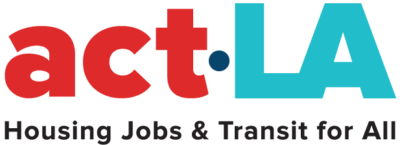‘Transit for All’ Report Highlights Need for L.A. City Strategy to Strengthen Neighborhoods
How can Los Angeles achieve equity in transit-oriented development? With tens of billions of public money currently being invested into the city’s transit system, this question has never been more urgent. ACT LA has a vision and is mobilizing to make it a reality. Read about our vision here in “Transit for All,” our white paper with recommendations from communities for city leaders about how to strengthen neighborhoods through affordable homes and support for small businesses.
In Los Angeles, households earning less than $25,000 a year account for over three-quarters of workers who commute via public transportation. Keeping these households near public transportation is the key to ensuring our $40 billion transportation investment is effective. Yet research shows that transit investment often drives up housing costs near transit corridors, thus pushing out the population proven to use it. To promote healthy, transit accessible communities that everyone can afford, “Transit for All” urges the city to proactively enact policies to protect residents and small business owners from displacement, thus ensuring real greenhouse gas and pollution reductions and improvements in public health.
“As the transit build-out occurs, and the city overhauls its zoning code, it’s important to understand the real threat these forces impose on low income communities that haven’t been brought into the conversation,” said Fanny Ortiz, a Boyle Heights resident and ACT-LA member. “The city needs to act aggressively to ensure that affordable housing for very low-income families near transit is created, so that gentrification doesn’t decimate entire communities.”
Key recommendations of “Transit for All” include:
- Preventing displacement, protect rent-stabilized housing, and provide opportunities for new affordable housing to be built near transit;
- Protecting community-serving small businesses, create quality jobs with family supporting wages for local residents and Angelenos who face barriers to employment; and
- Connecting bus and rail to safer streetscapes, open space and other amenities like workforce development, childcare and healthcare.
